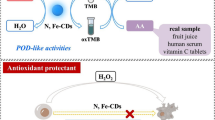Abstract
A review of the mechanisms of the exogenous redox compounds influence on the bacterial coupled enzyme system: NAD(P)H:FMN—oxidoreductase—luciferase has been done. A series of quinones has been used as model organic oxidants. The three mechanisms of the quinones’ effects on bioluminescence were suggested: (1) inhibition of the NADH-dependent redox reactions; (2) interactions between the compounds and the enzymes of the coupled enzyme system; and (3) intermolecular energy migration. The correlation between the kinetic parameters of bioluminescence and the standard redox potential of the quinones proved that the inhibition of redox reactions was the key mechanism by which the quinones decrease the light emission intensity. The changes in the fluorescence anisotropy decay of the endogenous flavin of the enzyme preparations showed the direct interaction between quinones and enzymes. It has been demonstrated that the intermolecular energy migration mechanism played a minor role in the effect of quinones on the bioluminescence. A comparative analysis of the effect of quinones, phenols and inorganic redox compounds on bioluminescent coupled enzyme systems has been carried out.
Similar content being viewed by others
References
S. H. Choi, M. B. Gu, Phenolic toxicity-detection and classification through the use of recombinant bioluminescent Escherichia coli cells, Environ. Toxicol. Chem., 2001, 20, 248–255.
R. J. Mitchell, M. B. Gu, An Escherichia coli biosensor capable of detecting both genotoxic and oxidative damage, Appl. Microbiol. Biotechnol., 2004, 64, 46–52.
V. A. Kratasyuk, E. V. Vetrova, N. S. Kudryasheva, Bioluminescent water quality monitoring of salt lake Shira, Luminescence, 1999, 14, 193–195.
V. A. Kratasyuk, E. N. Esimbekova, M. I. Gladyshev, E. B. Khromichek, A. M. Kuznetsov, E. A. Ivanova, The use of bioluminescent biotests for study of natural and laboratory aquatic ecosystems, Chemosphere, 2001, 42, 909–915.
D. I. Stom, T. A. Geel, A. E. Balayan, A. M. Kuznetsov, S. E. Medvedeva, Bioluminescent method in studing the complex effect of sewage components, Arch. Environ. Contam. Toxicol., 1992, 22, 203–208.
E. V. Vetrova, V. A. Kratasyuk, N. S. Kudryasheva, Bioluminescent characteristics map of Shira lake water, Aquat. Ecol., 2002, 36, 309–315.
N. S. Kudryasheva, E. V. Shalaeva, E. N. Zadorozhnaya, V. A. Kratasyuk, D. I. Stom, A. E. Balayan, Patterns of inhibition of bacterial bioluminescence in vitro by quinones and phenols-components of sewage, Biofizika, 1994, 39, 455–464.
S. F. D’Souza, Microbial biosensors, Biosens. Bioelectron., 2001, 16, 337–353.
N. Kudryasheva, E. Vetrova, A. Kuznetsov, V. Kratasyuk, D. Stom, Bioluminescent assays: Effects of quinones and phenols, Ecotoxicol. Environ. Saf., 2002, 53, 221–225.
N. A. Tyulkova, Purification of bacterial luciferase from Photobacterium leiognathi with the use of FPLC-system, in Luminescence, ed. B. Jezowska-Trzebiatowska, B. Kochel, J. Stawinski and W. Strek, Biological World Scientific, Singapore, 1990, pp. 369–374.
N. S. Kudrysheva, V. A. Kratasyuk, P. I. Belobrov, Bioluminescent analysis. The action of toxicants: Physical-chemical regularities of the toxicants effects, Anal. Lett., 1994, 27, 2931–2938.
E. V. Vetrova and N. S. Kudryasheva, Mechanism of quinones’ influence on bioluminescent enzyme system NAD(P)H:FMN-oxidoreductase-luciferase, in Bioluminescence & chemiluminescence: progress & current applications, ed. P. Stanley and L. Kricka, World Scientific Publishing, Singapore, 2002, pp. 101–104.
E. V. Vetrova, N. S. Kudryasheva, A. J. Visser, A. von Hoek, Characteristics of endogenous flavin fluorescence of Photobacterium leiognathi luciferase and Vibrio fischeri NAD(P)H:FMN-oxidoreductase, Luminescence, 2005, 20, 205–209.
van Hoek, A. J. W. G. Visser, Pulse selection system with electro-optic modulators applied to mode-locked cw lasers and time-resolved single photon counting, Rev. Sci. Instrum., 1981, 52, 1199–1205.
J. C. Brochon, Maximum entropy method of data analysis in time-resolved spectroscopy, in Methods in Enzymology, 240, Numerical Computer Methods, ed. B. M. L. Johnson and L. Brand, 1994, pp. 262–311.
E. G. Novikov, A. van Hoek, A. J. W. G. Visser, J. W. Hofstraat, Linear algorithms for stretched exponential decay analysis, Opt. Commun., 1999, 166, 189–198.
J. M. Beechem, E. Gratton, M. Ameloot, J. R. Knutson and L. Brand, The global analysis of fluorescence intensity and anisotropy decay data: Second-generation theory and programs, in Topics in Fluorescence Spectroscopy, Principles, ed. J. R. Lakowicz, Plenum, New York, 1991, vol. 2.
J. R. Lakowicz, Principles of Fluorescence Spectroscopy, Plenum, New York, 1999.
S. Inouye, NAD(P)H-flavin oxidoreductase from Vibrio fischeri ATCC-7744 is a flavoprotein, FEBS Lett., 1994, 347, 163–168.
S. C. Tu, Reduced flavin: donor and acceptor enzymes and mechanisms of channeling, Antioxid. Redox Signaling, 2001, 3, 881–97.
C. J. Wei, B. Lei, S. C. Tu, Characterization of the binding of Photobacterium phosphoreum p-flavin by Vibrio harveyi luciferase, Arch. Biochem. Biophys., 2001, 396, 199–206.
E. V. Vetrova, N. S. Kudryasheva, A. J. Visser, A. von Hoek, Characteristics of endogenous flavin fluorescence of Photobacterium leiognathi luciferase and Vibrio fischeri NAD(P)H:FMN-oxidoreductase, Luminescence, 2005, 20, 205–209.
R. Leenders, A. van Hoek, M. van Iersel, C. Veeger, A. J. W. G. Visser, Flavin dynamics in oxidized Clostridium beijerinckii flavodoxin as assessed by time-resolved polarized fluorescence, Eur. J. Biochem., 1993, 218, 977–984.
N. S. Kudryasheva, E. V. Nemtseva, A. J. W. G. Visser, A. van Hoek, Interaction of aromatic compounds with Photobacterium leiognathi luciferase: fluorescence anisotropy study, Luminescence, 2003, 18, 156–161.
E. V. Vetrova, Mechanisms of influence redox active compounds on coupled enzyme system NADH:FMN–oxidoreductase–luciferase, Teethes of dissertation, Institute of Biophysics SB RAS, 2002.
Author information
Authors and Affiliations
Corresponding author
Rights and permissions
About this article
Cite this article
Vetrova, E.V., Kudryasheva, N.S. & Kratasyuk, V.A. Redox compounds influence on the NAD(P)H:FMN—oxidoreductase—luciferase bioluminescent system. Photochem Photobiol Sci 6, 35–40 (2007). https://doi.org/10.1039/b608152e
Received:
Accepted:
Published:
Issue Date:
DOI: https://doi.org/10.1039/b608152e




